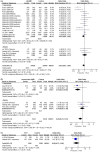Ethnic differences in the association of SERPING1 with age-related macular degeneration and polypoidal choroidal vasculopathy
- PMID: 25800435
- PMCID: PMC4371106
- DOI: 10.1038/srep09424
Ethnic differences in the association of SERPING1 with age-related macular degeneration and polypoidal choroidal vasculopathy
Abstract
Neovascular age-related macular degeneration (AMD) and polypoidal choroidal vasculopathy (PCV) are leading causes of irreversible blindness in developed countries. In this study, we investigated the association of single nucleotide polymorphisms (SNPs) in the serpin peptidase inhibitor, clade G, member 1 (SERPING1) gene with neovascular AMD and PCV. Two haplotype-tagging SNPs, rs1005510 and rs11603020, of SERPING1 were genotyped in 708 unrelated Chinese individuals: 200 neovascular AMD, 233 PCV and 275 controls. A meta-analysis was also performed for all reported associations of SERPING1 SNPs with AMD and PCV. None of the tagging SNPs had a significant association with neovascular AMD or PCV (P > 0.05) in our study cohort. The meta-analyses showed that the most-studied SNP rs2511989 was not significantly associated with all forms of AMD, neovascular AMD, or PCV in East Asians (P = 0.98, 0.93 and 0.30, respectively) but was associated with AMD in Caucasians (P = 0.04 for all AMD and 0.004 for neovascular AMD). Therefore, the results of our study and meta-analysis suggest that SERPING1 is not a major genetic component of AMD or PCV in East Asians but is a genetic risk factor for AMD in Caucasians, providing evidence for an ethnic diversity in the genetic etiology of AMD.
Figures




Comment in
-
Efficacy of aflibercept for polypoidal choroidal vasculopathy in Caucasians.Acta Ophthalmol. 2018 Feb;96(1):e94-e95. doi: 10.1111/aos.13461. Epub 2017 Jun 21. Acta Ophthalmol. 2018. PMID: 28636275 No abstract available.
Similar articles
-
Association between the SERPING1 gene and age-related macular degeneration and polypoidal choroidal vasculopathy in Japanese.PLoS One. 2011 Apr 19;6(4):e19108. doi: 10.1371/journal.pone.0019108. PLoS One. 2011. PMID: 21526158 Free PMC article.
-
The effect of genetic variants in SERPING1 on the risk of neovascular age-related macular degeneration.Br J Ophthalmol. 2010 Jul;94(7):915-7. doi: 10.1136/bjo.2009.172007. Br J Ophthalmol. 2010. PMID: 20606025 Free PMC article.
-
Gender specific association of a complement component 3 polymorphism with polypoidal choroidal vasculopathy.Sci Rep. 2014 Nov 12;4:7018. doi: 10.1038/srep07018. Sci Rep. 2014. PMID: 25388911 Free PMC article.
-
Genetic Association of Age-Related Macular Degeneration and Polypoidal Choroidal Vasculopathy.Asia Pac J Ophthalmol (Phila). 2020 Mar-Apr;9(2):104-109. doi: 10.1097/01.APO.0000656976.47696.7d. Asia Pac J Ophthalmol (Phila). 2020. PMID: 32195675 Review.
-
Genetic associations in polypoidal choroidal vasculopathy: a systematic review and meta-analysis.Mol Vis. 2012;18:816-29. Epub 2012 Apr 4. Mol Vis. 2012. PMID: 22509112 Free PMC article.
Cited by
-
Regulation of Complement and Contact System Activation via C1 Inhibitor Potentiation and Factor XIIa Activity Modulation by Sulfated Glycans - Structure-Activity Relationships.PLoS One. 2016 Oct 26;11(10):e0165493. doi: 10.1371/journal.pone.0165493. eCollection 2016. PLoS One. 2016. PMID: 27783665 Free PMC article.
-
Genes and genetics in eye diseases: a genomic medicine approach for investigating hereditary and inflammatory ocular disorders.Int J Ophthalmol. 2018 Jan 18;11(1):117-134. doi: 10.18240/ijo.2018.01.20. eCollection 2018. Int J Ophthalmol. 2018. PMID: 29376001 Free PMC article. Review.
-
Evaluation of the association of C5 with neovascular age-related macular degeneration and polypoidal choroidal vasculopathy.Eye Vis (Lond). 2019 Nov 7;6:34. doi: 10.1186/s40662-019-0161-2. eCollection 2019. Eye Vis (Lond). 2019. PMID: 31720301 Free PMC article.
-
Ethnic Differences in the Association Between Age-Related Macular Degeneration and Vision-Specific Functioning.JAMA Ophthalmol. 2017 May 1;135(5):469-476. doi: 10.1001/jamaophthalmol.2017.0266. JAMA Ophthalmol. 2017. PMID: 28358956 Free PMC article.
-
Optic disk melanocytoma associated with polypoidal choroidal vasculopathy lesions, after combination treatment of photodynamic therapy and intavitreal aflibercept (Eylea), a case report.BMC Ophthalmol. 2018 Oct 12;18(1):267. doi: 10.1186/s12886-018-0927-7. BMC Ophthalmol. 2018. PMID: 30309335 Free PMC article.
References
-
- Haddad S., Chen C. A., Santangelo S. L. & Seddon J. M. The genetics of age-related macular degeneration: a review of progress to date. Surv Ophthalmol 51, 316–363 (2006). - PubMed
-
- Dewan A. et al. HTRA1 promoter polymorphism in wet age-related macular degeneration. Science 314, 989–992 (2006). - PubMed
Publication types
MeSH terms
Substances
LinkOut - more resources
Full Text Sources
Other Literature Sources
Medical
Miscellaneous

